How to Use $20 on a String in Change Machines
We are fortunate to have the modern advances and the benefits of electronic devices, remote education and networking, cushioned seats and postural supportive office chairs. All these things have become increasingly more abundant in our daily lives, however, the detriment of longer commutes, hours working on a laptop and evenings slouched or reclining on the couch in the company of televisions, tablets, and smartphones can often contribute to an increased tendency for neck pain, "tightness," and muscle dysfunction.
While all of us may occasionally benefit from a few stretches to combat the poor postural habits associated with our sedentary lifestyle, managing neck and shoulder pain solely with stretching doesn't treat the source, rather than the cause of symptoms and provides only temporary relief. Therefore, I believe it is appropriate to reiterate the message given in my prior Athletico blog post on back strengthening.
In order to alleviate your agony, it is necessary to understand the cause of neck and shoulder tightness, or a majority of muscle tightness in general. Muscle tightness is often the symptom resulting from sustained positions and continuous muscle contraction. Our sedentary lifestyle requires neck muscles to function according to their role as endurance muscles, and therefore, postural stabilizers, acting as the "guywires" providing stability for holding you upright throughout the day. This task is not easy, and many of our necks are simply not up to the task resulting in the tightness we feel, a repercussion of these muscles "fighting" to keep our spines aligned. For that reason, the best treatment may not be neck stretching, but strengthening.
One of the initial factors I observe during a patient evaluation is posture. Forward head, rounded shoulders? Sound like the majority of the American population? The message this communicates to my brain as a physical therapist is scapular (shoulder blade) muscle weakness and poor deep cervical muscle strength. No wonder your neck is painful and tight!
Exercises to strengthen and stretch the muscles in your neck and shoulders
Cervical Retraction
- The single best exercise to improve posture and neck stability and one that can easily be performed sitting at your desk. Cervical retraction is best learned lying down.
- Lie on your back with your neck relaxed.
- Keeping your head on the ground, gently tuck your chin toward your chest as if making a double chin. Squeeze and hold for 5-10 seconds. Repeat 10 times.
- Avoid pushing your head into the floor and ensure you feel a contraction in the front of your neck.
- To perform cervical retraction seated, sit in an upright position with feet flat on the floor.
- Gently tuck your chin toward your chest keeping your eyes fixed on something in front of you. Squeeze and hold for 5-10 seconds.
- Avoid looking down or bending your neck forward.
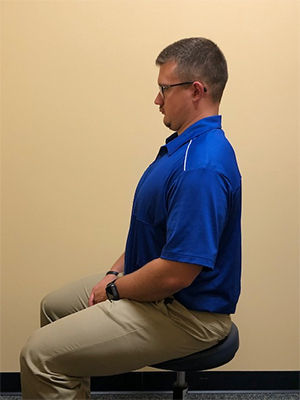
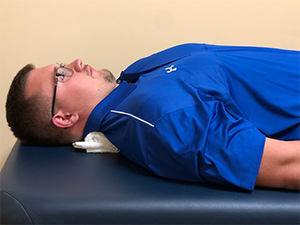
Isometric Cervical Side Bending
- Stand or sit in an upright position with head in a neutral position and your feet flat on the floor.
- Place your hand on the side of your head.
- Keeping your eyes fixed on something in front of you, push gently into the side of your head, resisting the motion with your neck muscles.
- Ensure your head remains steady.
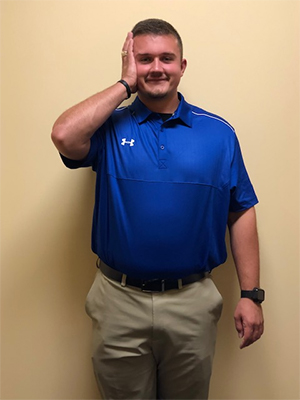
Scapular Retraction
- Begin sitting or standing with your back against a wall in an upright position.
- Squeeze shoulder blades together and downwards. Hold for 5-10 seconds. Repeat 10 times for 1-2 sets.
- Keep chin tucked, arms by sides of body and avoid shrugging shoulders.
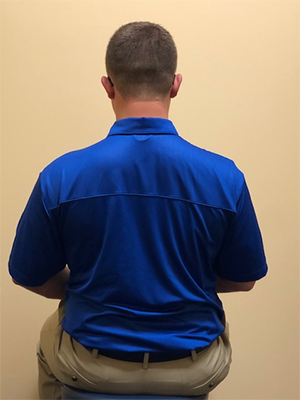
Theraband Row
- Stand with arms in front of chest holding the ends of a resistance band anchored at chest height.
- Bend elbows, pulling arms back against the resistance as if squeezing shoulder blades together.
- Keep back straight and avoid shrugging shoulders.
This exercise may also be performed on a gym machine or lying on your stomach with one arm hanging off the edge of a bed or table.
- In a prone position, bend and pull your elbow to the ceiling, squeezing your shoulder blade and keeping elbow tucked along body. Hold briefly.
- Avoid shrugging your shoulders.
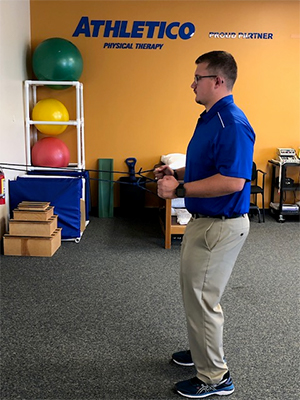
Theraband Shoulder Extension
Stand holding the ends of a resistance band anchored overhead with arms at shoulder height and palms facing floor.
- Pull your arms down to your sides, squeezing your shoulder blades together and downward.
- Ensure elbows remain straight and avoid shrugging shoulders.
This exercise may also be performed on a lat machine or lying on your stomach with one arm hanging off the edge of a bed or table.
- In a prone position with arm off side of bed and palm or thumb facing forward, raise arm toward ceiling by squeezing shoulder blade downward.
- Ensure elbow remains straight and avoid shrugging shoulders.
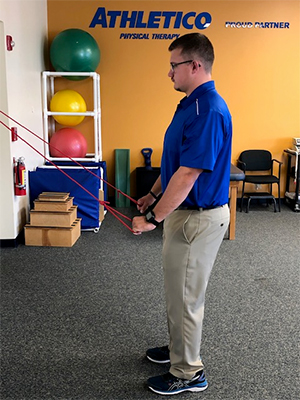
Levator Scapula Stretch
- Sit upright in a chair, grasping underneath the edge with one hand.
- Turn your head to the opposite side, look down toward opposite knee and tuck chin toward chest. Gently squeeze your shoulder blades together and downward.
- Place opposite hand on back of your head and gently pull downward toward knee until a stretch is felt. Hold 30-40 seconds.
- Ensure you remain sitting upright with back straight.
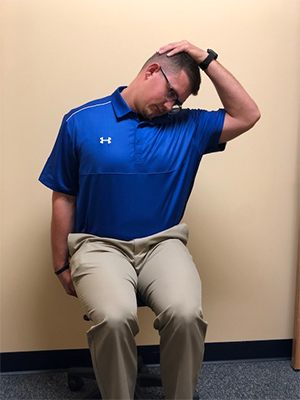
Doorway Chest Stretch
- Stand upright in the front and center of a doorway.
- Place palms and forearms on sides of the doorway at a comfortable height.
- Take a small step forward, pushing pelvis forward until a stretch is felt in the front of your shoulders. Hold 30-40 seconds.
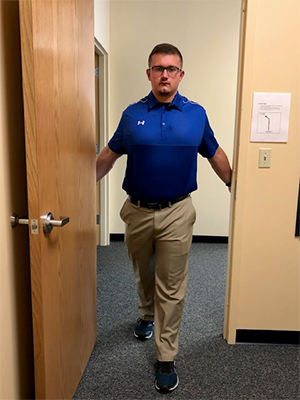
Prayer Stretch
- Kneel on hands and knees. Reach forward placing palms on ground while sitting your hips back. Hold 30-40 seconds.
- Breathe deeply and ensure shoulders remain relaxed.
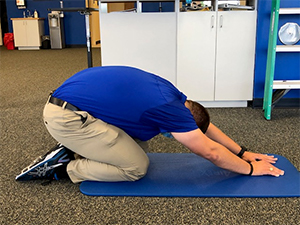
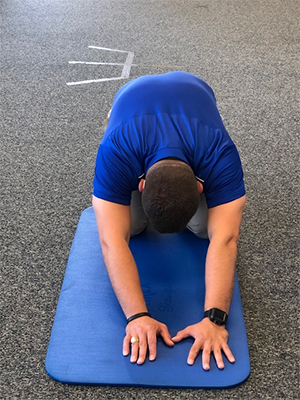
Posterior Capsule Stretch
- Stand with one arm raised in front of your body. Squeeze shoulder blade back.
- With opposite hand grasp back of your arm and gently pull it across your body until a stretch is felt in shoulder blade. Hold 30-40 seconds.
- Keep shoulder blade drawn backward and chest upright.
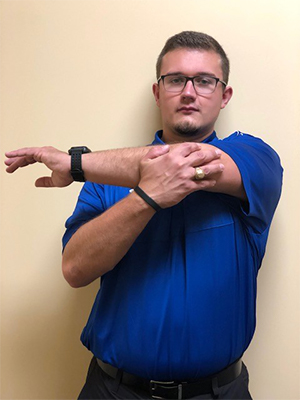
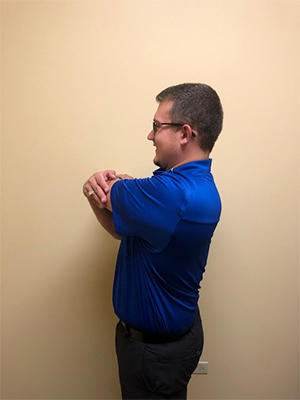
General Posture Guidelines
- Follow these recommendations to help decrease neck and shoulder tension and constant need to stretch.
- Change position, or ideally, stand every 20-30 minutes.
- Be mindful of poor postural habits and slouching
- Keep eyes level and sit upright as if a string through the top of your head is drawing you toward the ceiling.
- Perform cervical and scapular retraction to combat forward head and rounded shoulder positions assumed with long duration computer work or driving
- Avoid shrugging shoulders
If you have questions or concerns about your neck or shoulder pain, schedule a free assessment at your nearest Athletico clinic so our experts can take a look at your pain and provide recommendations for treatment.
Request a Free Assessment
Physical therapy is usually the thing you are told to do after medication, x-rays or surgery. The best way to fix your pain is to start where you normally finish – with physical therapy at Athletico. Schedule a free assessment in-clinic or virtually through a secure online video chat where our team can assess your pain and provide recommended treatment options.
The Athletico blog is an educational resource written by Athletico employees. Athletico bloggers are licensed professionals who abide by the code of ethics outlined by their respective professional associations. The content published in blog posts represents the opinion of the individual author based on their expertise and experience. The content provided in this blog is for informational purposes only, does not constitute medical advice and should not be relied on for making personal health decisions.

How to Use $20 on a String in Change Machines
Source: https://www.athletico.com/2020/10/16/9-exercises-to-strengthen-your-neck-shoulders/
0 Response to "How to Use $20 on a String in Change Machines"
Post a Comment